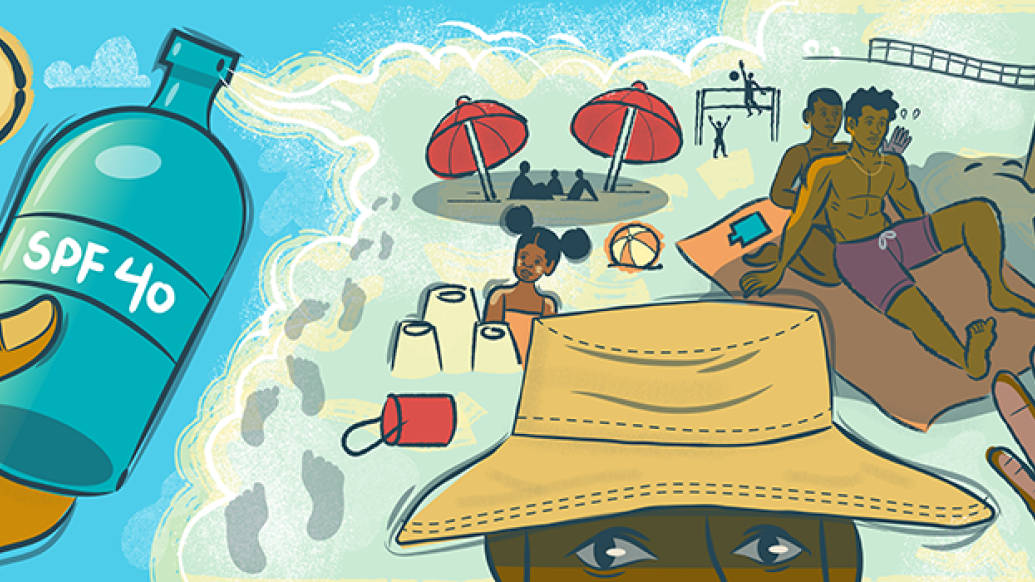Medical students place dispensers at parks, pools and golf courses to give people easy access to sunscreen
5:00 AM
Author |

Sometimes it’s better not to overcomplicate things.
So when students at the University of Michigan Medical School wondered what prevents young people from using sunscreen more often, they simply asked them.
And what they found?
Young people were well aware of the importance of sunscreen and the cancer risk that comes with repeated sunburns – the problem was, though, that sunscreen just wasn’t handy when it was needed.
To the med students, this seemed like an eminently solvable problem.
Their one study led to two developments: first, a successful JAMA Network journal publication for the med school students who conducted it.
Then, perhaps even more significantly, the creation of a program that now places sunscreen dispensers in places around Washtenaw County where young people are likely to need them the most.
“This all started based on findings from the research project we did, where we polled youth ages 14 to 24 throughout the country on their views toward sunscreen and sunburn,” said Olivia Lamberg, M.D., who graduated from the med school this spring.
“We found the main barrier to sunscreen use was access, not education or awareness. So we decided to meet them where they’re at by putting dispensers in places where they may be needed.”
The plan
Beginning in summer 2022, with a $10,000 grant from the Rogel Cancer Center, Lamberg and her fellow med students partnered with Ann Arbor Parks and Recreation, Michigan Athletics, and dispenser and sunscreen supplier Impact Melanoma to strategically place dispensers in places like pools, golf courses and outdoor athletic fields.
In the first two years, 17 dispensers were deployed across 13 locations in Ann Arbor.
About 10,000 applications of sunscreen from the dispensers were made, and an estimated 50,000 people have seen the dispensers and their sun safety messaging.
Starting this summer, the program is expanding to high schools in Ann Arbor and Ypsilanti.
“Certainly, when teens leave the house they are not first and foremost thinking of skin cancer prevention. Athletes are packing athletic gear, not sunscreen,” said Svati Pazhyanur, a medical student who will oversee the program in the coming year since Lamberg graduated.
“One advantage of this project is building a habit and building awareness. In that way, I think it’s been really beneficial.”
Tammy Chang, M.D., associate professor of family medicine at Michigan Medicine, has been involved with the students’ efforts from the beginning.
“This is such a wonderful example of how students are participating in research that can improve the health of their own communities,” Chang said.
“It turns out, young people actually have a lot of knowledge about the dangers of sun exposure. The problem really was operationalizing that knowledge.”
Chang adds that one of the keys to long term skin health is early and consistent use of sunscreen, and that doing so can pay huge dividends for years to come.
“Young people have this potential to change their behavior in ways that can benefit them for the remainder of their lives,” Chang said.
“The potential to impact health and improve the lives of young people is enormous.”
That realization helped drive the medical students’ participation in the program, which includes educational visits to Ann Arbor Parks and Recreation’s summer camps.
During the visits, medical students taught more than 250 youngsters about sun safety, using a combination of games to bring the lessons home.
“We’d do a lot of different games – relay races, have teams pick through different types of clothing to see which types are best in the sun, or have them dress up a teammate in sun safety clothing,” Lamberg said. “We have beads that change color in UV light, so we made bracelets and necklaces out of those," said Lamberg, who stated it visually highlights the difference between playing in the shade and playing in the sun.
For Pazhyanur, who now dedicates an estimated three to five hours a week to the project, the efforts are well worth it.
“We’re building a habit and building awareness, and in that way I think it’s been beneficial,” Pazhyanur said.
Because of Pazhyanur’s Indian heritage, the work has extra meaning for her: people of color, although typically less prone to skin cancer, tend to have worse outcomes because darker skin means melanoma is often detected later.
“The prevalence is lower than in people with lighter skin,” Pazhyanur said.
“But skin cancer is often caught later, and there’s a higher melanoma mortality among people of color.”
Chang says the heart of the program – and its greatest strength – is its roots in the community.
“The strongest aspect of this program is that it’s community driven,” Chang said.
“The idea came from young people who live and work in this community, and that’s why it works. Communities know best what is good for them.”
It doesn’t hurt, either, that it’s really pretty simple, she says.
“It’s not a fancy, complicated program,” Chang said.
“But sometimes the most simple programs, focused on what the community really wants, are the most effective.”

Explore a variety of health care news & stories by visiting the Health Lab home page for more articles.

Department of Communication at Michigan Medicine

Associate Professor
Want top health & research news weekly? Sign up for Health Lab’s newsletters today!





